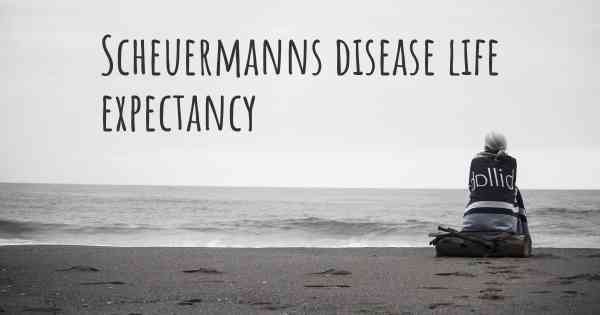What is the life expectancy of someone with Scheuermanns disease?
Life expectancy of people with Scheuermanns disease and recent progresses and researches in Scheuermanns disease

Scheuermann's disease is a spinal disorder that typically affects adolescents during their growth spurt. It is characterized by abnormal curvature of the spine, leading to a rounded or hunched back. While the condition can cause discomfort and limited mobility, it does not directly impact life expectancy. The long-term prognosis for individuals with Scheuermann's disease varies depending on the severity of the curvature and the presence of associated complications. Early diagnosis, proper management, and regular medical follow-ups can help alleviate symptoms and prevent further progression. It is important for individuals with Scheuermann's disease to maintain a healthy lifestyle, including regular exercise and good posture, to manage the condition effectively.
Scheuermann's disease, also known as Scheuermann's kyphosis, is a musculoskeletal disorder that primarily affects the spine during adolescence. It is characterized by abnormal growth of the vertebrae, leading to a rounded or hunched back, commonly referred to as kyphosis. While the condition can cause discomfort and impact quality of life, it is important to note that Scheuermann's disease does not typically affect life expectancy.
Causes and Symptoms:
The exact cause of Scheuermann's disease is not fully understood, but it is believed to involve a combination of genetic and environmental factors. Some studies suggest that it may be related to abnormal bone development or a disruption in the growth plates of the vertebrae. The condition is more common in males and tends to manifest during periods of rapid growth.
The most prominent symptom of Scheuermann's disease is the development of an exaggerated thoracic kyphosis, which can result in a visibly rounded upper back. Other symptoms may include back pain, stiffness, muscle fatigue, and limited flexibility. In severe cases, nerve compression or spinal cord involvement may occur, leading to neurological symptoms such as numbness, tingling, or weakness in the extremities.
Diagnosis and Treatment:
Diagnosing Scheuermann's disease typically involves a thorough physical examination, medical history review, and imaging tests such as X-rays or MRI scans. These imaging techniques help assess the severity of the spinal curvature and identify any potential complications.
While there is no cure for Scheuermann's disease, treatment aims to manage symptoms, improve posture, and prevent further progression of the condition. Non-surgical approaches are usually the first line of treatment and may include:
- Physical therapy: Exercises and stretches to strengthen the back muscles, improve flexibility, and correct posture.
- Pain management: Over-the-counter pain relievers or prescribed medications to alleviate discomfort.
- Bracing: Wearing a back brace for a specified period to support the spine and prevent worsening of the curvature.
In more severe cases or when conservative measures fail to provide relief, surgical intervention may be considered. Surgery aims to correct the spinal deformity, stabilize the spine, and relieve any nerve compression. The specific surgical procedure will depend on the individual's condition and may involve spinal fusion, osteotomy (bone reshaping), or other techniques.
Life Expectancy:
It is important to emphasize that Scheuermann's disease itself does not significantly impact life expectancy. The condition primarily affects the structure and alignment of the spine, causing physical discomfort and potential limitations in daily activities. However, with appropriate management and treatment, individuals with Scheuermann's disease can lead fulfilling lives and have a normal life expectancy.
It is crucial for individuals diagnosed with Scheuermann's disease to work closely with healthcare professionals, including orthopedic specialists and physical therapists, to develop a personalized treatment plan. Regular monitoring, adherence to recommended exercises, and lifestyle modifications can help manage symptoms, improve posture, and maintain overall spinal health.
Curves higher than 90 degrees can cause health issues with the lungs and heart so that would shorten life expectancy.
Posted Feb 28, 2017 by Mikeloveskorn 1720
Posted Nov 8, 2017 by Gaia Jasmine 2800








